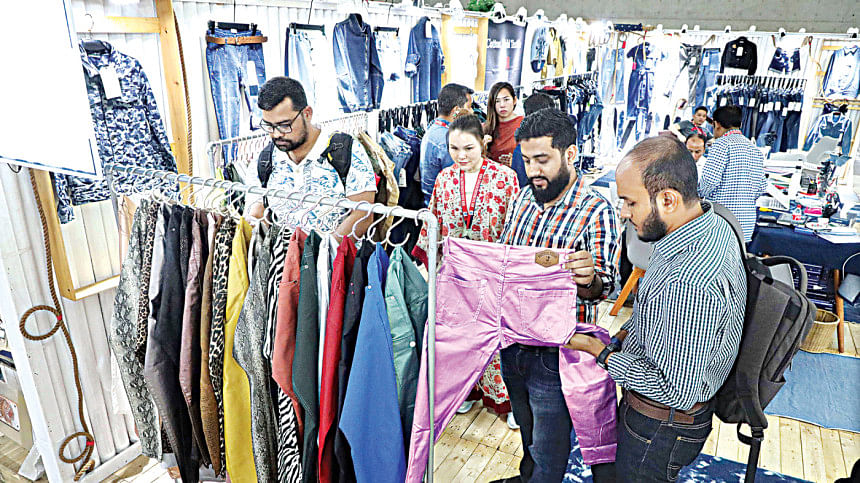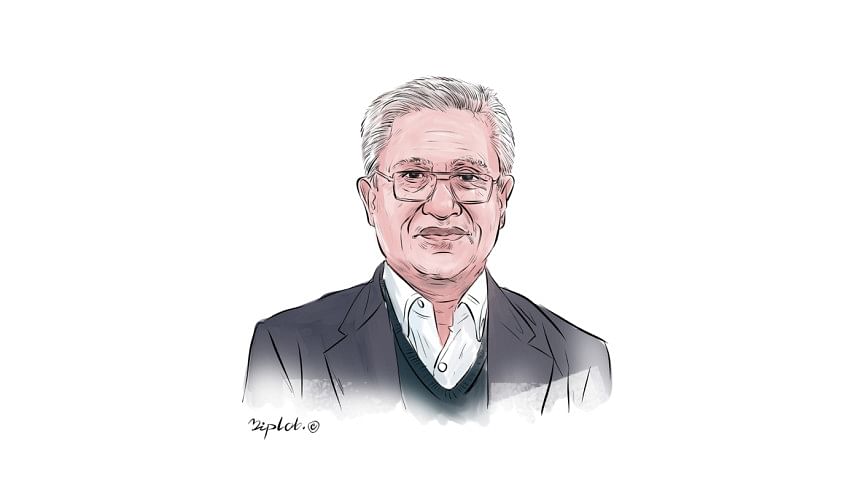A balancing act in turbulent times

BBS's provisional GDP growth estimates for FY25 unveiled a second consecutive year of growth recession. Given the trials Bangladesh has endured since the outset of the year, the numbers carry the story of the economy's adaptation to adversities. A 3.97 percent real GDP growth is at par with the IMF's 3.9 percent projected for Asia in 2025. It is not too bad considering the adverse natural and political weather that stressed a state struggling to function with hollowed institutions.
How did the economy manage to grow under disorderly conditions? What prevented worse outcomes, often seen elsewhere under similar headwinds? Tunisia and Egypt, following the Arab Spring of 2011, for instance. What stood in the way of doing better?
GROWTH UPHELD BY EXPORTS
Exports were the most distinguished drivers of growth. After a steep 17.1 percent decline in FY24, real exports are nowcasted to rise 12.9 percent in FY25, a 30 percentage point turnaround. This rebound is only partly attributable to downward corrections in FY24 export data.
Merchandise exports grew 8.6 percent in the first 10 months. All major product categories maintained positive growth except dry food, jute and jute goods. Knitwear, denim, and high-value items like outerwear and lingerie are among the fastest-growing segments. Non-RMG export growth was better but not strong enough to make a difference to the pre-existing composition of exports.
Export growth correlates strongly with manufacturing growth, which reportedly increased from 3.16 percent in FY24 to 5.68 percent in FY25. Large industries dominated the share of recovery. Shortages of gas notwithstanding, electricity provision supported output expansion in large manufacturing amidst labour unrest, factory closures, and mobility disruptions.
Street protests have occurred regularly, often multiple times per week, since August 2024, making FY25 one of the most sustained periods of political unrest in Bangladesh's recent history.
Export growth came mainly from the traditional markets. Exports to the EU, US, and Canada grew 10.46 percent, 15.97 percent, and 14.14 percent (July-April, FY25). The EU accounted for 49.91 percent of total RMG exports, followed by the United States (19.23 percent). Growth in nontraditional markets like India (17.35 percent), Turkey (31.75 percent), and Japan (10.32 percent) geared up from a low base but declined in the UK. Bangladesh's apparel exports to the US market outpaced its competitors in the first four months of 2025, growing 29.33 percent year-on-year. Bangladesh may have benefited from the pull-forward strategy of buyers as they hedged against uncertainty unleashed by Trump's Liberation Day tariffs.
PROPPED BY REMITTANCES
Production and trade in Bangladesh used to be bound by a foreign exchange shortage in recent years. This changed in FY25 as the recession in the hundi market diverted remittances from the informal to formal channels. Remittances from Bangladeshi expatriates boomed 28.6 percent in July-May compared to the same period the year before.
As illicit outflows diminish, formal remittance inflows rise. This is conclusively evident from the post-August 2024 behaviour of formal remittances. The numbers employed, their incomes and the propensity to remit could not have changed so much all of a sudden. Displacement of money traffickers due to regime change is therefore the most plausible as the trigger, taking remittances towards a new historic high of $30 billion in FY25. However, the corresponding positive effects of a decline in illicit financial outflows on domestic revenue mobilisation and capital accumulation are yet to transpire, perhaps because they are never immediate and, more importantly, in the current context, other enablers are still missing.
The foreign exchange market and the banking system benefited from the increased forex transfers across Bangladesh's financial borders. They enabled clearing arrears accumulated due to forex shortage without drawing down BB's reserves or net open positions of banks. This averted supply disruptions (especially fertiliser, coal, LNG) and improved confidence in the ecosystem of trade and investment financing.
BB transitioned from a crawling peg to a flexible market-based exchange rate regime with no official rate ceilings and no phone suasion. Exchange controls such as US dollar rationing often distort the level playing field by prioritising connected firms on the backfoot if not in the rear-view mirror.

THROTTLED BY ADVERSITIES
Devastating floods swept through several northeastern and southeastern regions between August 21 and early September 2024, affecting approximately 5.8 million inhabitants. The resulting fall in crop production accounts largely for the decline in agricultural growth to 1.79 percent in FY25 from 3.3 percent in FY24. Production growth in fishing increased from 0.79 percent in FY24 to 3.24 percent in FY25, credit to floodplain management, protecting breeding grounds, and resilient infrastructure that steered floods to expand fish habitats, migration and breeding, and replenish nutrients in wetlands.
Political unrest in different shapes and sizes persisted throughout the year. There isn't a precise count, but street protests have occurred regularly, often multiple times per week, since August 2024, making FY25 one of the most sustained periods of political unrest in Bangladesh's recent history.
The unrest didn't just shake the streets; it chilled economic growth and investor confidence. Work orders from global brands like H&M, Zara, and VF Corp declined by nearly 10 percent for the 2025 autumn-winter season due to safety concerns and cancelled buyer visits. The tech and startup ecosystem faced delays in foreign investment.
Growth in the services sector slowed considerably, reflecting decelerations in domestic trade and transport. These sectors depend heavily on social order and continued public services in the daily course of their business. Urban trade and transport are especially vulnerable to the cascading effects of sudden stops caused by holding streets hostage.
DENIED BY CAPITAL ACCUMULATION
The investment intensity of the economy has been declining since FY22. This worsened in FY25. Gross capital formation decelerated to 1.76 percent in FY25 from an already low 2.2 percent in FY24. The provisionally estimated total investment rate dropped 132 basis points in FY25 alone, out of a cumulative 267 basis points decline since FY22, when the rate stood at around 32 percent of GDP.
The estimated positive growth in capital formation in FY25 contrasts with LC settlement and opening data for capital goods imports. LC settlement was down by 25.6 percent and LC opening by 27.5 percent in July-April FY25 in nominal dollar terms. BBS's estimate of the growth in capital formation may thus be erring on the high side.
A down-trending private investment rate, coupled with a near-constant share of manufacturing in total output, suggests the economy only moved sideways on structural change in FY25.
EXPECTATIONS BUOYANT NONETHELESS
Performance in FY25 was better on stability than growth compared to the previous year. The government has projected 5 percent growth in FY25, rising subsequently by 50 basis points each year during FY26-28 in their Medium-Term Macroeconomic Policy Statement FY26-28. Inflation will decelerate from 9.05 percent in May to 6.5 percent in FY26, followed by a 50 basis point drop each year during FY27-28.
Rising growth and disinflation can coexist when global commodity prices are soft, the US dollar is weak, interest rates are low, and foreign exchange liquidity and energy supplies do not bind. For growth to rebound, it durably requires, in addition to industrial peace, secure movement of people and property and a credible macro-structural policy regime. None of these can be taken for granted in today's world. Just when you think it's getting a little clearer, something else comes along, damaging the path of recovery.
WALKING THE WALK
Escalation of trade barriers, persistent policy uncertainty, and rising geopolitical tensions are huge downsides that need shielding. Threats to some bring opportunities for others.
For instance, the Trump administration's preference for country-specific tariffs is equivalent to levying a general tariff on all imports while providing a production subsidy to competing producers from all the countries not covered by the same extent of reciprocal tariffs. Countries able to attract orders and production capacity diverted from China and the US are on the receiving side of this subsidy.
US tariffs on China may remain an order of magnitude higher for most goods than the 10 percent baseline for the rest of the world, at least until the US administration manages to get all the 150-plus bilateral deals done. The inherently protracted nature of this process has opened opportunities for countries like Bangladesh to find their niche in the supply chain restructurings already happening or queuing to happen.
As a more predictable global trading regime emerges, pent-up foreign direct investment will follow countries ahead in the trade policy game currently being played out. LDC graduation in 2026 will change the game for Bangladesh further. Bangladesh will have to find a dominant new set of trade policy serving best the national interest in a world where sudden disruption appears to have joined death and taxes in the list of lifetime certainties!
The writer is a former lead economist at the World Bank's Dhaka office.

 For all latest news, follow The Daily Star's Google News channel.
For all latest news, follow The Daily Star's Google News channel. 



Comments